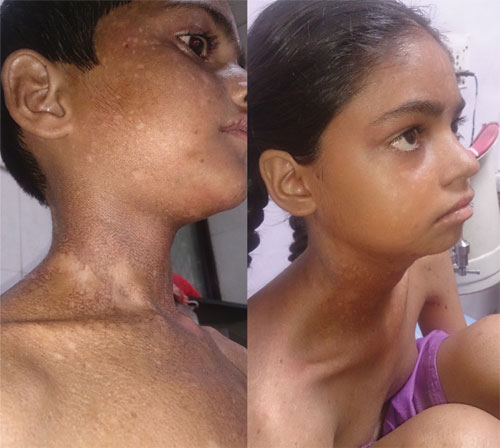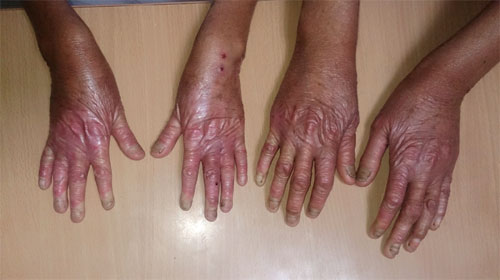|
|
|
Indian Pediatr 2018;55: 85 |
 |
Kindler Syndrome
|
|
Vibhu Mendiratta and *Meenu Malik
Department of Dermatology and STD, Lady Hardinge
Medical College and associated hospitals, New Delhi, India.
Email: meenumalik01@gmail.com
|
|
Two siblings, a 13-year-old girl and an 8-year-old
-boy (birth order 4 and 6) born out of a first degree consanguineous
marriage, presented to us with recurrent trauma-induced clear or
hemorrhagic acral blisters that healed without scarring, and cutaneous
pigmentation. The blistering improved with age. There was history of
similar acral blistering and anal stenosis in their first born sibling
who died at the age of 12 days. Five other siblings were normal.
Photosensitivity, oral ulcers, gum bleeding, dysphagia and constipation
were present since birth. Cutaneous examination revealed poikiloderma
mainly affecting face, neck and upper chest; multiple hyperpigmented
macules over trunk and extremities; and cigarette paper like atrophy
over abdomen and dorsae of hands and feet (Fig. 1). Facial
skin was shiny and stretched. Palmoplantar keratoderma, syndactyly,
webbing of fingers and toes, sclerodermatous changes and reduced
dermatoglyphics were noted (Fig. 2). Poor dental
hygiene, oral ulcers, gingivitis, periodontitis along with anal stenosis
were also seen. Ectropion (both eyes), nail dystrophy, and thick, long
cuticles over finger and toe nails were present. Patients lacked any
neurodevelopmental delay. A diagnosis of Kindler syndrome was made due
to typical clinical features. Symptomatic treatment was administered in
the form of photoprotection, broad spectrum sunscreen, lubricant eye
drops, dental care, laxatives and emollients. Kindler syndrome is a rare
genodermatoses characterized by congenital or infantile acral
blistering, photosensitivity, poikiloderma, diffuse cutaneous atrophy
and mucosal involvement (urethral meatal, anal and esophageal stenosis).
Ectropion, gingivitis, leukoplakia, squamous cell carcinoma, hypo – or
anhidrosis, poor dentition, webbing between fingers and toes,
pseudoainhum, syndactyly, sclerodermatous changes and nail dystrophy may
be seen. It results from loss of function mutations in FERMT1 (filopodin
and ezrin/radixin/moesin) or KIND1 (kindlin) gene encoding
kindlin-1, a protein involved in actin-extracellular matrix linkage via
focal contact that affects cell adhesion, signaling, morphogenesis,
differentiation and migration. Immunostaining with anti-kindlin-1
antibody can be used as new diagnostic test. Early diagnosis of Kindler
Syndrome aids in genetic counseling. Annual follow up for early
detection of premalignant keratosis and malignancies is advocated due to
risk of squamous cell carcinoma on acral areas or oral mucosa.
 |
|
Fig. 1 Poikiloderma affecting face,
neck and upper chest.
|
 |
|
Fig. 2 Sclerodermatous changes, and nail dystrophy
with long cuticles.
|
|
|
|
 |
|

